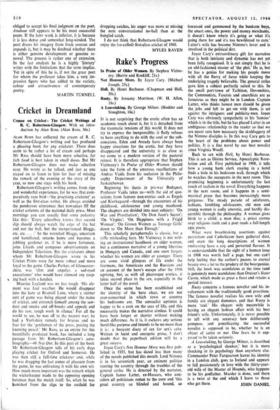Perse's Verse
Saint-John Perse: A Study in his Poetry. By Arthur Knodel. (Edinburgh University Press, 35s.) 'THE performance is worth beholding,' runs the concluding sentence of Professor Knodel's study of Saint-John Perse. The choice of noun and verb is a happy one. 'Performance' is the right word for the achievements of Alexis Leger: the diplomat who rose to the top of his profession before being dismissed by a defeated and un- grateful government; the poet who won the Nobel Prize, and the man who was more suc- cessful than any other contemporary writer in separating his professional from his literary life. 'Beholding brings out the element of remoteness and aloofness in this most patrician of poets.
The professor calls him 'the untimely poet.' This was certainly the impression created when his work was introduced to English readers by T. S. Eliot's translation of Anabase in 1930. A generation accustomed to the Fisher King and his parched realm, to the gnomic utterances of parts of The Waste Land and to the mental mountains of 14opkins's sonnets found it diffi- cult to grasp the significance of the Conquistador or to appreciate the vast open spaces of Perse's Orient and the sweep of his prose poetry. Fashions in poetry have changed since those days, but the difficulty remains and has not been diminished by Perse's later work.
The reader,' said Eliot in his preface,
to allow the imag,es to fall into his memory suc- cessively without questioning the reasonableness of each at the moment: so that, in the end, a total effect is produced.' It was sound advice. Although Perse uses a very extensive and some- times a highly technical vocabulary, he is essen- tially a creator of images. The figure of the 'exile,' one of the leitmotifs of his poetry, first appeared in the early Images a Crusoe. In Anabase it is interwoven with that of `conquest.' The central character is the Conquistador, arriv- ing in an unknown land, founding a new city, giving it laws, providing an administration, then departing in search of fresh fields to conquer. We therefore have the complex figure of the Conqueror-Exile-Stranger: the man who, like his creator, is an 'exile' from his own land and a 'stranger' in another.
The theme of 'exile' and conquest' acquired a new and tragic significance in the poems written during Perse's wartime exile in America. The rich oriental scenery was replaced by what seemed a barren, hostile landscape in poems appropriately entitled Evil, Vents, Pluies and Neiges. The tragic phase passed; in his latest work, like A niers and Chronique, with their images drawn from sea and earth, which Pro- fessor Knodel describes as `votive' poems to distinguish them from the poems of `exile,' the note is one of optimism and acceptance of the human lot.
Professor Knodel's study is academic in a favourable sense. It offers a very thorough examination of the whole of Perse's surviving work, explaining the difficulties in so far as they are explicable and commenting sensitively on the unquestionable beauty of much of the language. This does not mean that we are obliged to accept his final judgment on the poet. Anabase still appears to be his most successful poem. If the later work is inferior, it is because it is less dense and somewhat long-winded. The poet draws his imagery from fresh sources and expands it, but it may be doubted whether there is either genuine development or genuine re- newal. The process is rather one of extension. In the last analysis he is a highly 'literary' writer with the limitations that the term implies. Yet in spite of this he is, if not the great poet for whom the professor takes him, a very im- pressive figure who has added to the variety, colour and attractiveness of contemporary Poetry. MARTIN TURNELL































 Previous page
Previous page